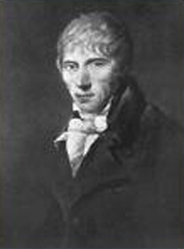
"That it is the native soil which really supports the weight of traffic; that while it is preserved in a dry state, it will carry any weight without sinking."
The Oxford English Dictionary defines "macadamizing " as the process of compacting into a solid mass a layer of small stone on a convex, well-drained roadbed. The word is derived from John Loudon McAdam, a man whose engineering fame in England was rivaled only by his contemporary Thomas Telford. McAdam's name became synonymous with the process of roadway construction, and his robust, cost-effective road designs complimented the canal systems developed throughout the British Isles during the industrial revolution.
John Loudon McAdam was born in Ayshire, Scotland, on September 21, 1756. The youngest of ten children, John was sent to the New World at the age of 14 upon the death of his father. There he teamed up with his affluent uncle William McAdam to run a prosperous mercantile business in the budding harbor town of New York. As the business's profits grew so did the reputations of John and William, and in 1772 William was named president of the New York Chamber of Commerce and John was elected Treasurer in 1774 at the age of 18. Mounting tensions between the Colonies and Britain darkened John's bright future, and his fate was sealed with his marriage to Gloriana Nicoll.
The Nicoll family had been sent by King Charles II in the 1670s to claim the territory of New Netherlands on behalf of his brother, the Duke of York. Neither McAdam nor his bride was willing to betray the Nicoll proud heritage. When the revolution broke out John enlisted in a loyalist regiment and served as a British government contractor. After the defeat of the British Army, those who fought against the Colonies, including John McAdam and his wife, forfeited all property to the new American government. The couple was repatriated to England in 1783, where they bought a house in Ayrshire, Scotland.
Though McAdam and his wife had lost a fortune, their loyalty to the crown was rewarded and McAdam soon became a prominent public figure. While serving as Deputy-Lieutenant of his county, McAdam noted the horrible road conditions throughout Scotland and England. Most were uneven, dangerous to travel on and costly to repair. In response, McAdam invented a road system that was rivaled only by the road design of Thomas Telford. Instead of digging out roadways, McAdam raised them to promote water run-off. Digging outflow ditches on each side further enhanced run-off, and the layering of different size stones created the elevated roadbed. Large stones were laid for the base followed by stones no larger than four ounces. McAdam had realized that loose stones would pack tightly under the weight of traffic and provide a stable, even ride.
Avoiding the introduction of clay, dirt, or sand on the road surface further enhanced stability. McAdam roads didn't wash away, lasted longer, and handled any weight or size of vehicle, thus making contemporary regulations concerning vehicle size and weight irrelevant. Most of all, McAdam roads could be constructed at a fraction of the cost of more established road construction techniques. In 1801 McAdam accepted the post of surveyor to the Bristol Turnpike Trust. By 1818, he was a consulting surveyor for no fewer than 34 road trusts.
The growing demand for his methods prompted McAdam to write two books, The Present System of Road Making (1816) and Practical Essay on the Scientific Repair and Preservation of Roads (1819). By 1923, the number of road trusts consulting McAdam had risen to 70, with many of them managed by one of his three sons. McAdam was appointed Surveyor General of Metropolitan Roads in Great Britain in 1827, and in 1830 the French Government adopted the McAdam system of road construction. Prior to his death McAdam was offered a knighthood, which he declined because of failing health. His oldest son James accepted the honor in his place.
Cancel
